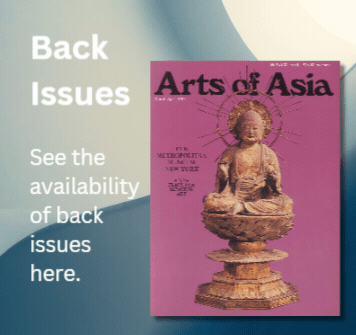AIMÉE FROOM
Curator, Art of the Islamic Worlds at the Museum of Fine Arts, Houston
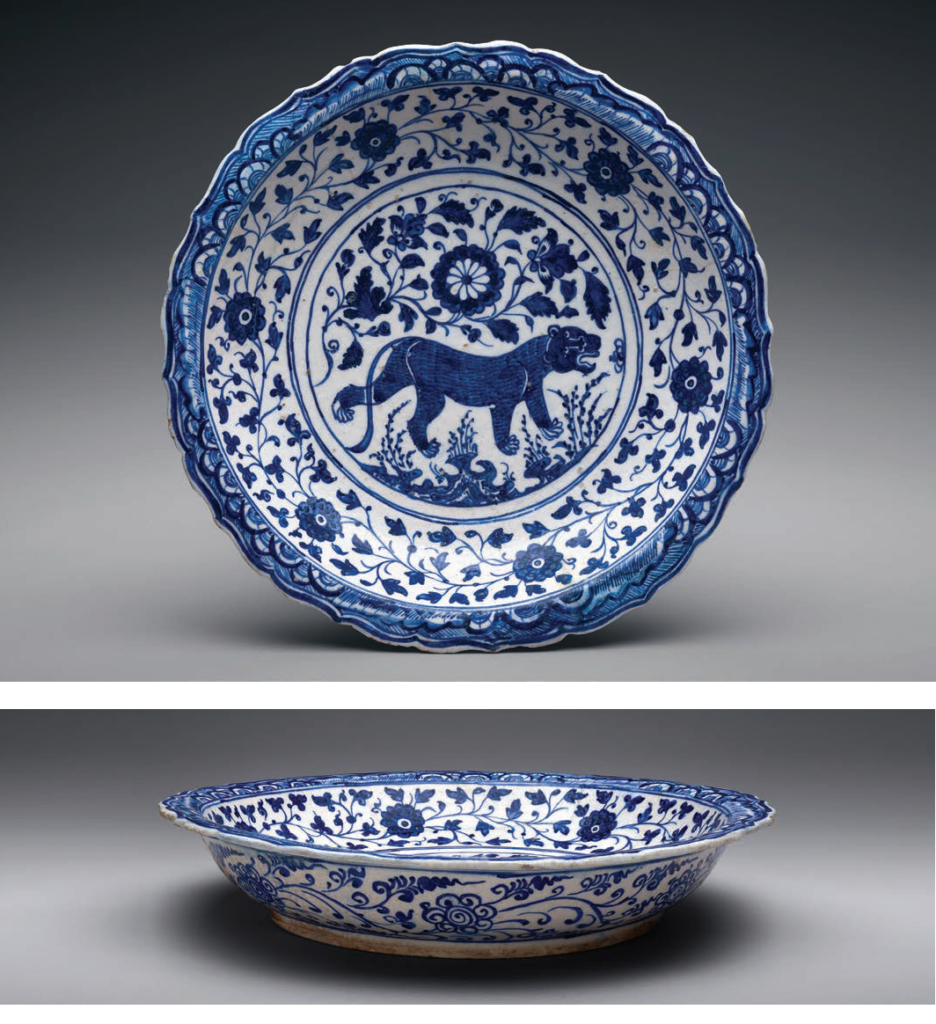
THE INSPIRATION for this series of articles and the exhibition, “Between Sea and Sky: Blue-and-White Ceramics from Persia and Beyond at the Museum of Fine Arts, Houston”, started with a single dish (1). From a sea full of waves cresting at the edges of the scalloped rim to the sunlike blossom above the central lion, one dish skilfully blends Chinese and Persian themes. Several hundred years of artistic exchange and trade coalesce into this dish that combines the brilliant blue and white palette and designs of Jingdezhen potters with the lion and sun motif, an ancient Persian symbol of kingship seen throughout Persian lands well into the 19th century. Ceramics always have fulfilled an important role in Islamic societies, from functional earthenware pots to gleaming lustrous tiles adorning palace walls. The development of blue and white ceramics and, in particular, the artistic, technical and economic exchange between Persia and China, is a fascinating subfield receiving more scholarly attention. 1 This article will focus on blue and white through the unique lens of an exceptional group of Persian blue and white ceramics dating from the 9th to the 17th century, which are part of a larger, more comprehensive, collection of Persian art from the Hossein Afshar Collection on long-term loan to the Museum of Fine Arts, Houston (MFAH).2 These ceramics, studied together for the first time, will add to our understanding of blue and white ceramics in a Persian and Islamic context and shed light on a more nuanced interpretation of the contribution of Persian blue and white ceramics to the world history of ceramics.

Early Blue and White Ceramics
The story of the interaction of blue and white wares between Persia and China, and beyond, gained momentum with the overland routes and maritime trade plying the blue waters of the Persian Gulf between China and the Abbasid port city of Basra, Iraq. By the late 8th century, locally produced earthenware, covered with a lead and tin oxide-opacified glaze, supplied the elite of the Abbasid Empire (750–1258) with an alternative to imported Chinese wares, primarily Tang dynasty (618–907) green-splashed glazed wares. The local wares were simply decorated, sometimes with cobalt blue, which was sourced in Iran and the Arabian Peninsula. Cobalt blue was not a novelty; it had been used for centuries in the glass industries of Egypt and Syria, as well as for ceramic tiles in Susa, Iran, at the palace of the Achaemenid king Darius I (reigned 522–486 BC). In the mid-9th century, an Arabian dhow, laden with several thousand ceramics from China, sunk in the Java Sea off the coast of Belitung; among the recovered wares were some blue and white ceramics thought to have been commissioned by Basra merchants, suggesting existing trade relationships between Chinese and Abbasid merchants and makers by this time.
Early blue and white bowls feature geometric shapes, plant-like motifs or Arabic inscriptions in Kufic script (2). Epigraphy has been a popular form of ornament for several centuries on ceramics and other artistic media across all Islamic lands. The art of the word can be considered the highest form of Islamic art, as it transmits the word of God through the Qur’an. Inscriptions on ceramics are usually secular, offering blessings and good health to the owner. Nestled within stylised palm leaves on one bowl are three lines of Arabic Kufic script which have been partially read as:
“Blessing to its owner, work of . . . [ undeciphered]”

There are several contemporary bowls with similar inscriptions and the last part of the inscription has been read as the name “Salih”, or alternately as the phrase “what was done was worthwhile”.4 The high frequency of signatures on early blue and white bowls is unusual in the history of Islamic ceramics.


Stone-Paste Revolution
Regional dynasties flourished across the Abbasid Empire as the centralised power and authority of the caliph declined. The rise of upwardly mobile merchant and professional classes provoked a significant surge in artistic production, creativity and innovation. A transformation of the Persian ceramics industry took place in the second half of the 11th century when potters created a new ceramic called stone-paste (alternately called fritware) by mixing together, according to one recipe, one part fine white-coloured clay and one part crushed alkaline glass frit with ten parts crushed and sieved quartz. This recipe—as recorded in a 1301 AD treatise by Abu’I-Qasim, from a prominent Kashan family of potters—yielded a fired product that was close to the hard, white, translucent Chinese porcelain imports. 5 While the smaller amount of clay in stone-paste reduced malleability in comparison to the earthenware fabric, potters adapted production for stone-paste by making smaller wheel-thrown pieces joined together with slip and they experimented with techniques from other media, like moulding and casting. The layer of opaque white glaze over buff-coloured earthenware fabric, now eliminated with the white stone-paste fabric, meant that potters could test different glazing techniques, such as underglaze, monochrome and lustre.
Many of the deluxe ceramics from this period were made in Kashan, a city with a long tradition of luxury ceramic production, as well as other centres across Persian lands. Early experiments with stone-paste included lightweight, elegant bowls covered simply in transparent alkaline glaze, which may have taken inspiration from Chinese Song dynasty (960–1279) imports. Potters also tried out different shapes, many of which were inspired by Islamic metalwork, such as a moulded ewer complete with metalwork-style thumb rest (3).6 Under a thick coat of cobalt blue glaze, the upper half of the rounded body features Arabic benedictions to its owner: “Glory and prosperity and well-being and happiness and long life to its owner” a formula common in these wares:

The inscription is embellished by a meandering vine scroll animated with birds and animals; made in a mould, this decoration stands up in relief and in dramatic contrast to the depths of the dark blue pooling of the cobalt glaze in the crevices.
Zoomorphic decoration could take on a more prominent role, as in a bull’s head ewer (4), which reflects long-standing traditions of bird and animal-headed ceramic and metalware vessels produced in both Persia and China. Liquid would have been poured into the cup-shaped opening on the handle and flowed out the bull’s round mouth. Cobalt blue stripes run down the length of the body, linking this ewer with a contemporary group thought to have been produced in Kashan. Cobalt was challenging to control, but potters became adept at applying it, as on a bowl with sharply defined and tightly spaced blue stripes that converge into a dizzily blurred centre, like spokes on a wheel in motion (5).

Persian Blues
In addition to cobalt, turquoise and lapis lazuli, sourced from mines in Iran and Afghanistan, figure prominently in a range of arts from this period. All three of these brilliant blues were valued as precious and rare materials, treasured locally and exported east and west. Sometimes blues were combined, as in a bowl with bold, triangular stripes of cobalt radiating out from a central cruciform shape. The cobalt wedges, alternating with turquoise and white wedges, emphasise the typical open, shallow form of the dish, whose exterior is simply covered with cobalt (6). Turquoise, which is created by adding copper to an alkaline glaze, is called firuzeh in Persian, the name of the gemstone. Jewel-coloured ceramics evoked wealth and luxury. This symbolism was popular under the llkhanid dynasty (1256–1335) and continued in the Timurid period (1370–1507).

Turquoise glaze is used to brilliant effect in a round bowl filled with a shoal of black fish swimming anticlockwise in unison to form a hexagon or rosette in the centre, where the glaze has pooled to a deep sea blue (7). The aquatic effect must have been magnified when the bowl was filled with liquid. This bowl follows the lines of the lotus bowl type exported from the Longquan kilns of southern China during the Song (960–1279) and Yuan (1271–1368) periods. On the Persian example, the lotus flower petals are painted simply in black on the bowl exterior and not moulded. The Chinese prototype usually includes a pair of swimming fish, meant to symbolise happiness and a harmonious mar riage.7 Swimming fish are frequently found on ceramics, glass and metalwork from this period in Persian lands and also from Egypt and Syria, especially under the Mamluks (1250–1517). Fish painted in gold, and highlighted in red enamel, swim along the exteriors of tall glass beakers.8 The interiors of large brass ablution basins are also decorated with a sea full of inlaid silver fish, as in a Persian brass basin from the Hossein Afshar Collection.9 Like the fish on the contemporary ceramics, the shoals of fish in the metalwork basins often radiate towards a central rosette, which can be compared to a sun and this combination can be interpreted as auspicious for the wealth of the vessel’s owner.10

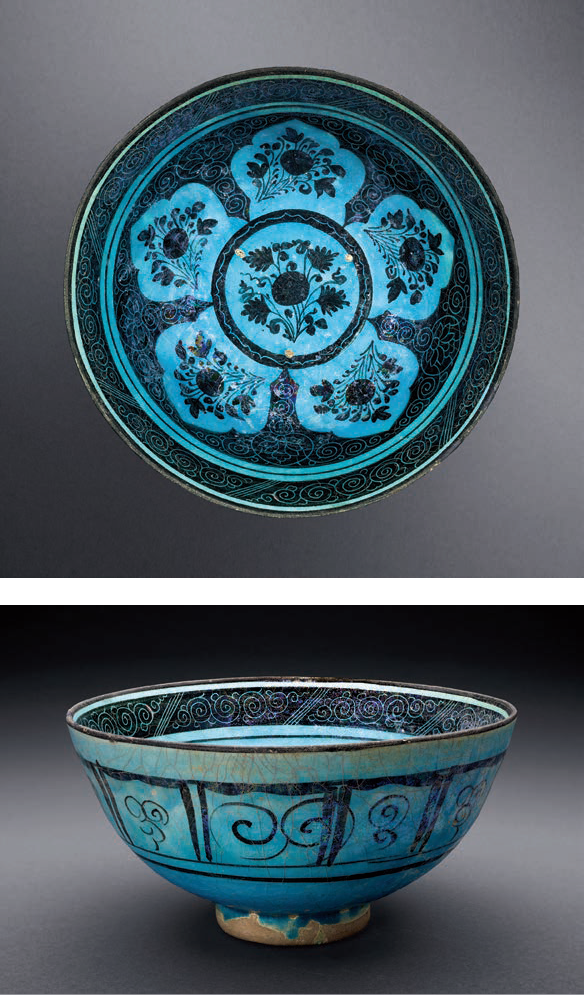
Black decoration under turquoise glaze was an enduringly popular colour combination, which can be seen over a century later on a 15th century bowl decorated with floral motifs, painted in black and scrolling patterns incised through black slip (8). The black floral motifs are framed by large lobed petals of reserve turquoise, that render the overall pattern legible from a distance. This pattern was also produced in black under transparent glaze, as demonstrated by a nearly identical bowl also in the Hossein Afshar Collection (9). Bowls like these relate to similarly painted and carved slip-painted stonewares from Cizhou kilns in China.11 It is unclear that the Chinese stonewares were the direct source of inspiration for these bowls though, since Persian potters at Kashan were already producing “silhouette” wares to similar effect with black slip and reserve areas of turquoise glaze. A number of intact and fragmentary bowls related to the 15th century black and turquoise bowl survive, with dated examples from this group ranging from 1468–1495 and petrographic analysis of one dish pointing to Nishapur, a city well known for fine ceramic production.12
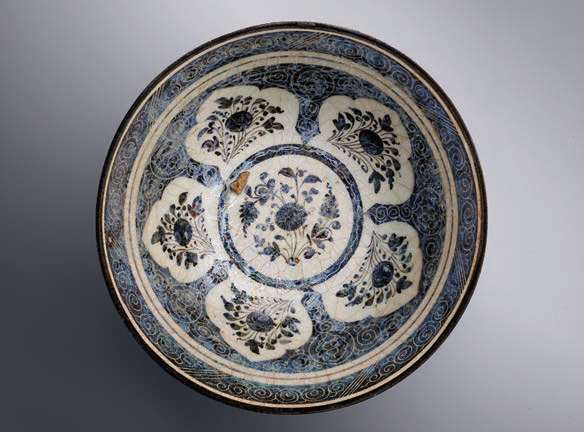
Tiles of Blue and Gold
Unprecedented artistic, economic and cultural exchange between Persia and China took place after the Mongol invasions of the late 12th and the early 13th century and the subsequent establishment of the Yuan dynasty in China, the Chagatay Khanate in Central Asia (circa 1227–1363), the Golden Horde Khanate in southern Russia (circa 1227–1502) and the Ilkhanid dynasty in Persian lands (1256–1335). From luxury silks to lustre ceramics, gold jewellery, precious metalwares and the lavishly illuminated manuscripts, Persian visual culture was infused with a vibrant new vocabulary of Chinese decorative motifs.
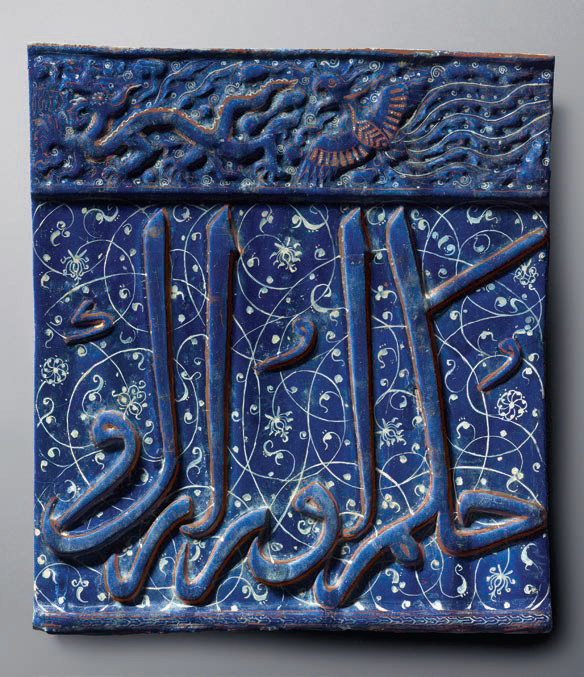
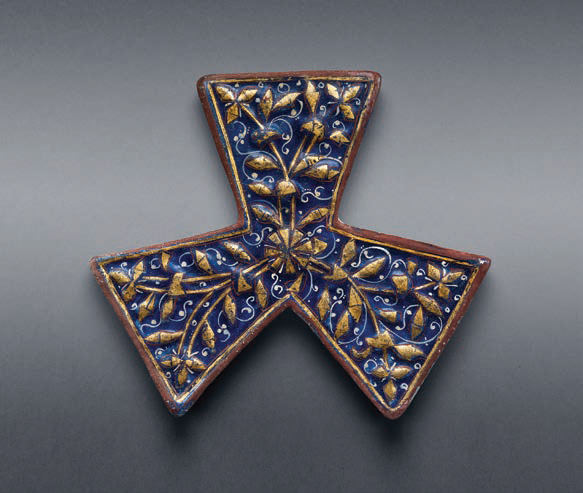
Many new palaces and religious buildings were constructed during this period, including Takht-i Sulayman, a summer palace and hunting retreat for the Ilkhan Abaqa Khan (reigned 1265–1281), built in the 1270s south-east of Tabriz.13 Structures were ornamented with tiles depicting Chinese floral and vegetal motifs as well as imperial symbols of power, such as the dragon and phoenix (10). This power combination continued to be used over the centuries, the phoenix transforming into the fantastical simurgh bird of Persian literature.14 The lower register derives directly from the Islamic art of the word with an inscription, part of a longer text, in Persian: “His command is from pre-eternity and … “15

It is unclear if “His command” is divine or secular and two very similar tiles do not yield any clues either. One, in the British Museum, reads in Persian “the kingdom of the world”, while another in the David Collection, Copenhagen, contains both a Qur’anic inscription in Arabic and phoenix/simurghs, a most unusual combination. 16
Tiles like this have been called “lajvardina” after the Persian term for lapis lazuli although they were not made with the semi-precious stone. The deep-blue colour on this tile and others (11, 12) comes from cobalt. Application of gold on the raised, moulded decoration adds a further element of luxury. The polygonal tile (11) and star tile with a Chinese crane (12) would have been combined with other similarly decorated tiles of different shapes in puzzle-like fashion to form a glittering, complex dado.17
Star tiles were produced in other costly techniques such as lustre, which was sometimes combined with blue pigment decoration. Kashan lustre tiles were used prominently during the Ilkhanid period, particularly for the decoration of shrines and palaces. Star tiles featuring single animals, such as this horse tile (13), also would have lined the walls of the summer palace, Takht-i Sulayman. The border, which is set off in blue, contains a Persian quatrain attributed to the 13th century Sufi author, Majd al-Din Baghdadi, and a date:

Do you know, o my admired one, why
My two oppressed eyes are full of tears?
My eyes draw from the desire of your lips,
Water from the mouth of my pupils.
Year 690(?) (1291–1292 AD)18
In addition to the Hossein Afshar Collection tile, there are at least three more lustre star tiles edged with the same calligraphic borders on blue ground framing dappled horses.19 One, in the David Collection in Copenhagen, is the closest comparison and is dated a year earlier, to January–February 1290.20 A tile in the Museum of Fine Arts, Boston, was produced twenty years later, in 1310,21 and a third star tile, in the British Museum, is undated.22 Underglaze painting remained a popular option for architectural tiles, as demonstrated by a deep cobalt blue star tile (14), and the vogue for black-outlined blue and white ceramics lasted well into the 17th century. 23
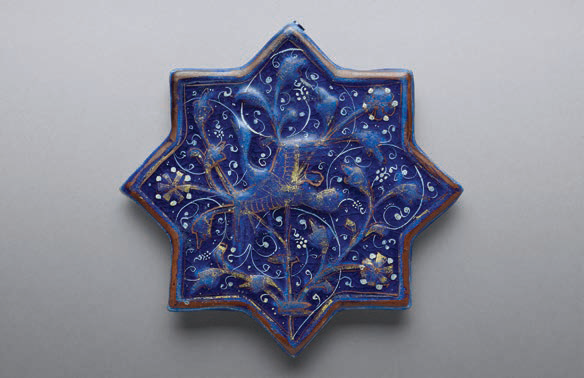
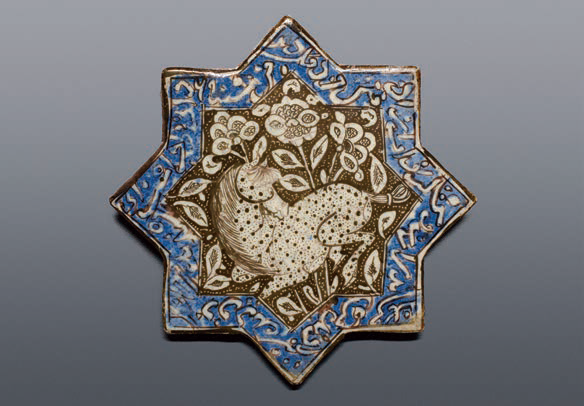
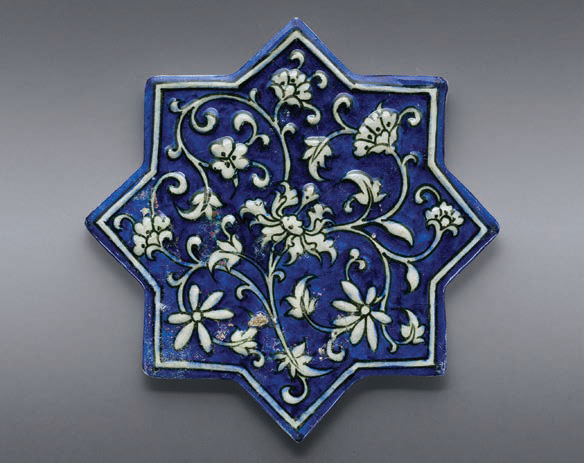
Blue and White from China to Persia
It was in the 14th century that qinghua, or blue-decorated wares, the celebrated blue and white Chinese porcelain recognised around the world today, started to be produced in the venerable ceramic city of Jingdezhen in the province of Jiangxi, south-eastern China. The flashy, very large serving vessels were not intended for domestic consumption. They were made for export to satisfy the tastes and communal dining requirements of the clients of Persian and Arab merchants. Persian potters and Persian cobalt, in China during the Yuan period, may have actively contributed to the growth and evolution of the industry.24
It was under the Yongle emperor’s reign (1403–1424) that porcelain of the best quality, guided by the strictest standards, was produced at Jingdezhen. These are the treasured Chinese blue and white porcelain vessels in the imperial collections of the Safavids in Iran, the Ottomans in Turkey and the Mughals in India. In the absence of such Chinese blue and white porcelain currently in the MFAH collection—an area we seek to expand—our colleagues in west Texas at the San Antonio Museum of Art (SAMA) have generously lent some important examples from their stellar collection to the exhibition (15, 17, 19). 25 The most significant piece is a very fine 14th century Yuan dish featuring a lotus pond with pair of mandarin ducks, auspicious as a symbol of a happy marriage (15). Yuan dishes with ducks and other early classic types of Ming dynasty (1368–1644) blue and white porcelain were highly prized at Islamic courts and can be counted among treasures in the Ottoman Topkapi Palace Museum and the Safavid Shrine at Ardabil, repositories of great significance, which will be discussed further below. 26 The San Antonio dish is particularly important for it includes a Persian inscription in nasta’liq script on the exterior of the inverted foot ring, which reads, “Shah Jahan ibn Jahangir Shah”, and a date, 1043 (16), which corresponds to 1633–1634.27 The dish was part of the royal collection of the Mughal emperor Shah Jahan (reigned 1628–1658), son of Emperor Jahangir. The San Antonio dish can be identified as one of an exclusive group of works inscribed with Shah Jahan’s name as cited by Krahl. 28 These prized possessions even travelled between Islamic courts, as confirmed by one very large Ming grape dish with a Shah Jahan inscription with accompanying date, AH 1053/AD 1643–1644, and an inscription indicating it was endowed to the Razavi shrine by Mahin Banu (1519–1562), a princess who was a daughter of the founder of the Safavid dynasty, Shah Ismail I (reigned 1501–1524).29
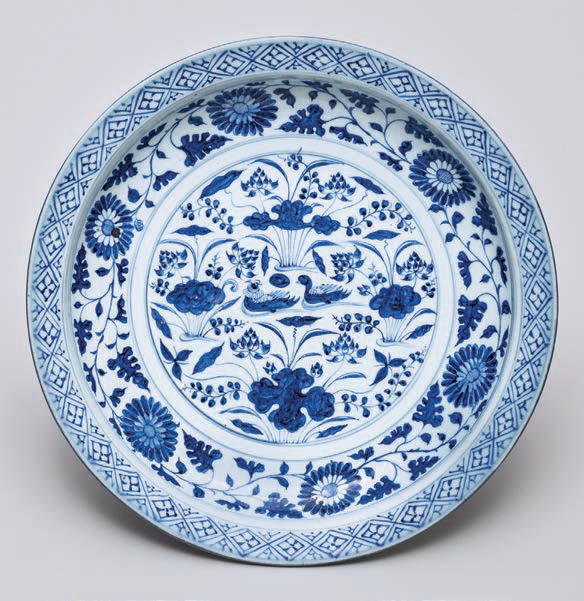
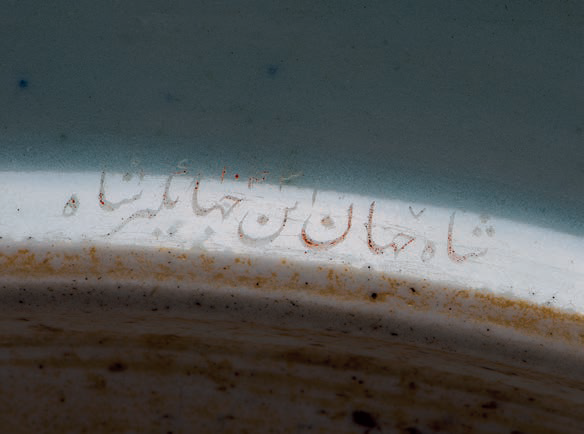
A second dish in the San Antonio collection (17), from the Yongle period, is of a type that is represented by eleven dishes in the Ardabil Shrine, Iran, and is related to the Chinese porcelain collected at the Topkapi Palace, Istanbul. 30 The central floral quartet and cresting wave pattern of the San Antonio dish were picked up by Timurid potters in Iran and combined with a lobed rim and individual blossoms in the cavetto, another early Ming pattern (18). The deep blue, black and light blue spots on the San Antonio dish, known as the heaped and piled effect, are from the uneven spread of the iron-rich cobalt through the glaze. The blue pigment imported from Persian lands was supplemented with a cobalt ore, which contained iron oxide.31 This desired effect was recreated in later, archaising pieces, like the San Antonio Museum’s 18th century Qianlong moon flask (19), which is a fascinating encapsulation of cross-cultural currents of influence that stretch back centuries: recreated elements of early Ming (Yongle and Xuande, 1426–1435) pieces with the heaped and piled effect and baoxiang blossoms, but the flattened vessel form itself derives from mid-13th century Syrian metalwork flasks. 32
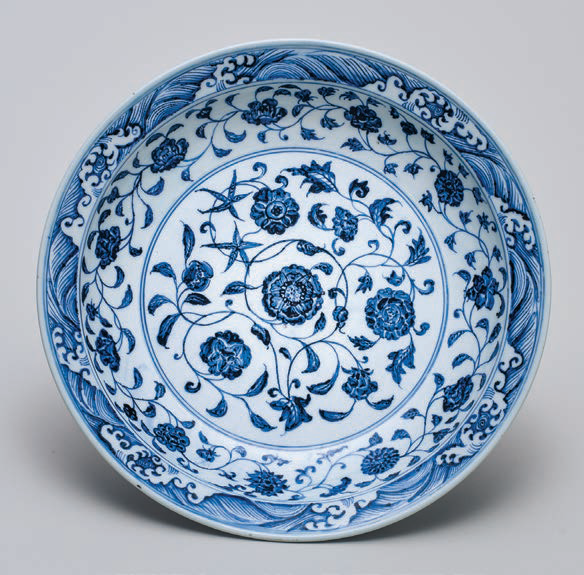
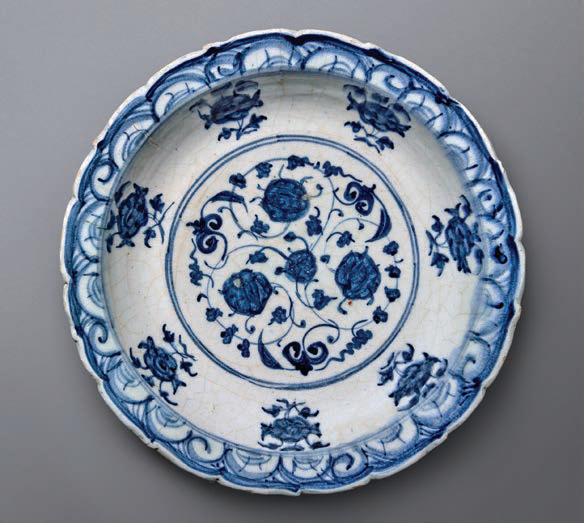
Blue and White Ceramics under the Timurids (circa 1370–1507)
Blue and white ceramic production flourished during the Timurid period (circa 1370–1507) in Samarqand, Nishapur, Mashhad and Tabriz. Potters still sought inspiration from Yuan and early Ming motifs, but adapted and combined them with elements of decorative grammar from the international repertoire of Timurid design ateliers to create fresh and inventive new pieces. A delightful duck and lotus pond dish in the Hossein Afshar Collection underscores the complex hybridity of blue and white ceramic production at this time (20). The dish mixes elements from multiple possible sources, like a Yuan period form—a large, shallow dish with lobed rim created and intended for the communal dining common in Islamic cultures—with a design programme of concentric bands, that can be traced back to Islamic metalwork or to lustre and underglaze ceramics from Kashan if the development of earlier Chinese blue and white pieces reflects a partnership between Chinese and Persian potters.33 The organisation of the central floral composition recalls late Yuan and early Ming period Chinese prototypes, as well as patterns for Timurid architectural tiles and manuscript illumination, that would have been conceived in a central design atelier and transferred to the individual workshops.
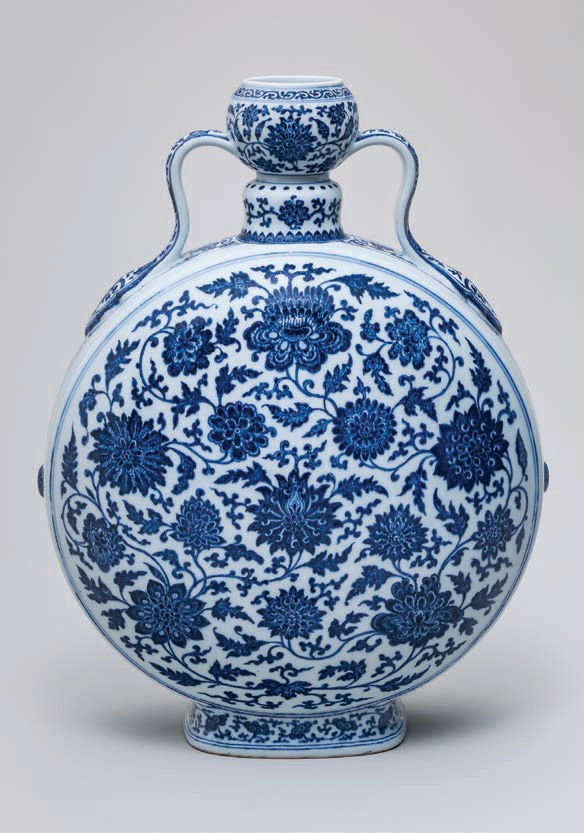
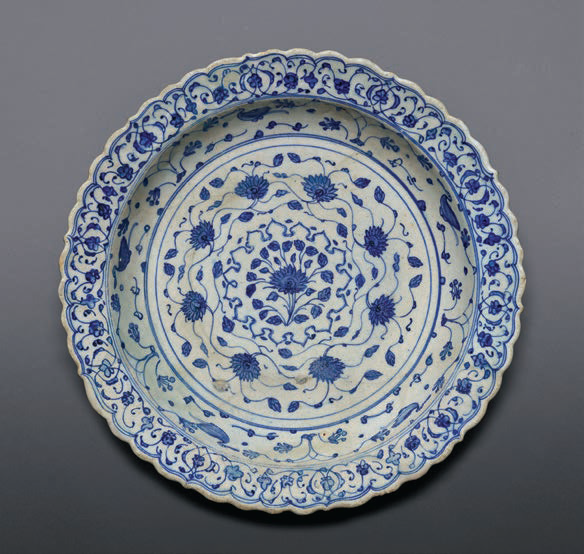
Another dish takes cultural hybridisation even further (1). A number of Chinese echoes are immediately visible, like the cresting wave scroll pattern on the lobed rim as well as the similar shape, size and placement of bands of concentric decoration as in the aforementioned serving vessel. The characteristic rosette vine scrolls on the cavetto and the exterior, as well as the bright blue, precisely detailed painting of early Yuan and early Ming motifs, place this dish with the so-called “Precise” group of ceramics produced in Tabriz in the late 15th century under the Turkman Aq Quyunlu (“White Sheep”) dynasty.34 What is unique about this dish is the main composition within the central medallion. The subject of a lion is not unusual; Chinese lions are a familiar theme that persisted well into the 17th century on Safavid ceramics (see 21). This, however, is not a curly-maned, bushy-tailed lion dog. His compact frame and focused facial expression with open jaw recall the lions seen in contemporary manuscript painting in Herat and Tabriz.35 The rosette above the lion is also noteworthy. Unlike the other floral motifs on the dish, its central petals are reserve white surrounded by a two-toned cobalt petal collar. The unusual painting of this sun-like blossom and its prominent position above the lion seem to evoke the lion and sun motif, a perennial symbol of kingship and power in Persian visual culture. In 1404, Ruy Gonzales de Clavijo, the Spanish envoy, remarks, for instance, upon the tiled emblem above the entrance to the Aq Saray palace of Timur (reigned 1370–1405) in Samarqand:
This gateway is throughout beautifully adorned with very fine work in gold and blue tiles, and over the entrance are seen the figures of the Lion and the Sun, these same figures being repeated over the summit of each of the arches round the courtyard, and this emblem of the Lion and the Sun was they told us the armorial bearing of the former lord of Samarqand [whom Timur dispossessed] .36
The lion and sun motif persisted in many different media through the centuries up to the Qajar period (1779–1924), when it was notably painted in brightly coloured enamels on medallions as part of decorations bestowed as an honour granted by the government for distinguished service to domestic and foreign officials, starting under Fath ‘Ali Shah (reigned 1797–1834).
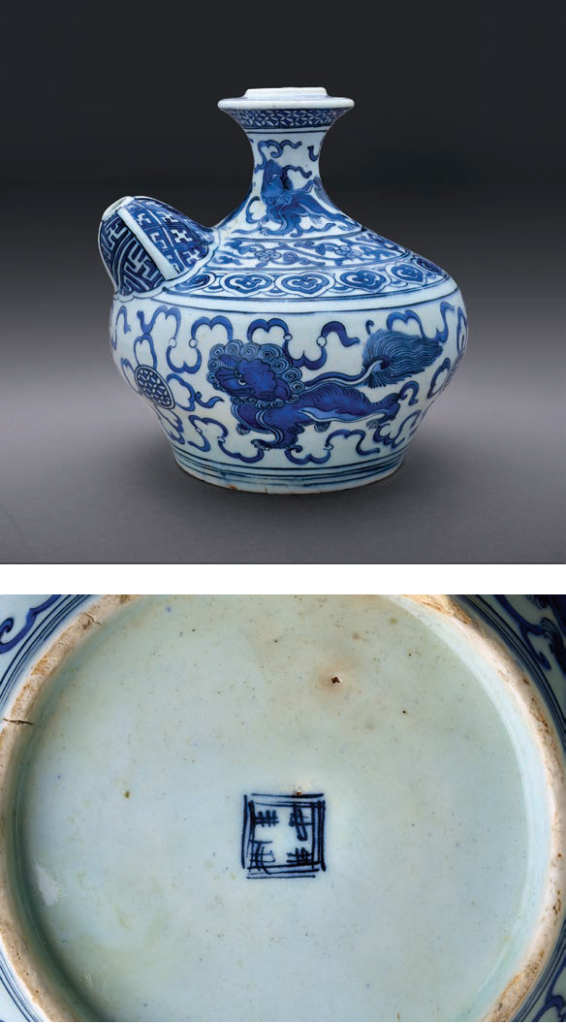
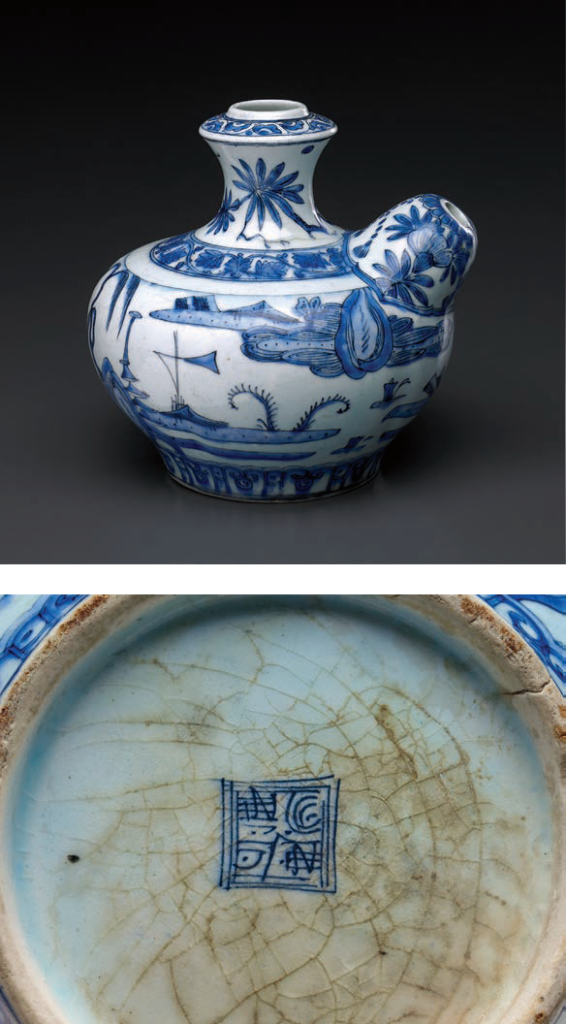
Blue and White Ceramics under the Safavids
The Safavid Shah ‘Abbas I (reigned 1588–1629) contributed more than 1000 pieces of Chinese porcelain from his personal collection in 1604 to the Ardabil Shrine, which houses the tomb of Shaykh Safi, founder of the Safavid Sufi order and ancestor of the Safavid dynasty. A chini-khana, or “china house”, was set up with porcelain examples on display for entertainment, according to Olearius, who visited in 1637.37 Shah ‘Abbas encouraged trade and Chinese porcelain flowed more freely to Persia after the Safavids, with the English, retook control of the Persian Gulf trade in 1622. After 1652, the next three decades saw insignificant importation of Chinese porcelain and, during this period, some Persian blue and white wares were marketed as Chinese by the Dutch East India Company (VOC) agents in what was dubbed by one as the “Persian interlude”, as discussed by Squires.38
The Persian ceramics industry thrived in the 17th century, producing an assortment of vessels in many different techniques—including blue and white—that were an integral part of the urban landscape of the Safavid elite in the capital city of Isfahan, as documented by written records, the colourful tile panels depicting garden picnics, and many single-page paintings and drawings. Squires’ article in this issue examines some of the blue and white bottles, cups and hookah bases in the Hossein Afshar Collection, that would have animated daily life in the coffeehouses and gardens of cosmopolitan Isfahan. The fashion for smoking tobacco with a water pipe, or qalyan, sparked production of wide range of ceramic and metalware vessels. One new ceramic shape stands out as a true cultural hybrid, a creative adaptation of form, function and decoration (21, 22). The bulbous-shaped body with two spouts copies the Chinese kendi, or pouring vessel, made at Jingdezhen for export to South and Southeast Asia—where the ancient form was originally developed—and to the Middle East and Europe. Production has been linked with the fine pottery workshops in Kirman from the second quarter of the 17th century onward.39 Two qalyans in the Hossein Afshar Collection are classic examples.40 The decoration of these vessels was characteristic of “Kraak” ware in Europe, named after the Portuguese ships, caracca, bound for Asia and Europe carrying Chinese porcelain like this produced during the period of the Wanli emperor (reigned 1573–1620) and later. The vessels’ bases contain Safavid potters’ marks, which imitate Chinese reign marks (nianhao), but do not convey meaning. These marks can be linked to Kirman production.41
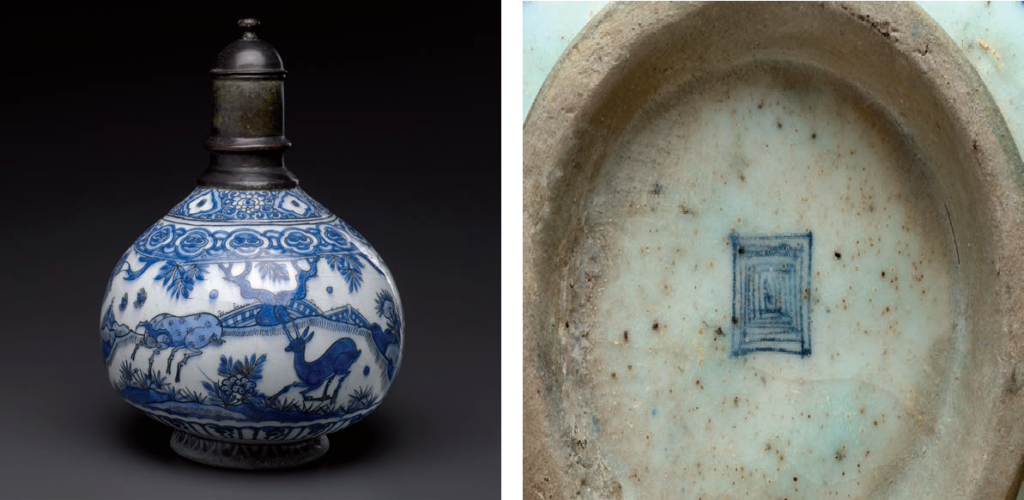
A bottle (23), with a leafy landscape filled with jaunty deer and other leggy quadrupeds bordered by ruyi motifs on the shoulder, was produced around the same time as the two qalyans. Its pear-shaped body and long neck made it an ideal companion for picnics en plein air in Isfahan’s gardens. Quadrupeds were a popular motif for these contemporary blue and white pieces. A fierce-looking, cloven-hoofed fantastic animal, with flaming wings and a bushy mane and tail, fills the tondo of a large deep bowl in the Hossein Afshar Collection (24). Flames and rocky fingers frame this qilin-like creature. This bowl, and similar ones in the Ashmolean Museum and the Victoria and Albert Museum, are directly related to a mid-16th century Chinese model in the Topkapi Palace Museum.42 The exquisitely detailed lotus scroll pattern on the Hossein Afshar Collection bowl recalls similar patterns on the exteriors of 15th century Chinese closed vessels, including one in the Ardabil Shrine.43 Blue and white deep bowls, whether of Chinese or Persian production, also appear in single-page paintings and drawings of dervishes after Shah ‘Abbas’ porcelain donation to the shrine of Shaykh Safi, founder of the Safavid Sufi order, at Ardabil; for example a tinted drawing of a pensive, solitary dervish in a landscape features prominently in the foreground a delicately painted blue and white deep bowl (25).44 It is interesting to note that the artist depicts a flowering plant on the exterior instead of the typical meandering floral scrolls seen on pottery bowls.


There was a proliferation of new forms and vessel types in the 17th century, but large serving dishes persisted as a mainstay for blue and white ceramic production. An important example is one that features six black cartouches with Persian verses in nasta’liq script, and “65” or “75”, which may be interpreted as a date, AH 1065/AD 1654–1655 or AH 1075/AD 1664–1665 scratched through the slip (26).45 This dish is part of a group of nine dishes with black bands attributed to Kirman and dated from 1654–1680 by Golombek.46 The base features a tassel mark, considered a diagnostic of Kirman production in the mid-17th century, and there are Kraak-style panels on the exterior.47
The Persian verses inscribed in the six black cartouches allude to the gastronomical function of the dish:

When the sun turns yellow in the dark-blue sky,
I am reminded of saffron rice on a lapis-coloured dish.48
According to Kwiatkowski, the text is a variant on verses attributed to Abu Ishaq (Bushaq) Shirazi, a 15th century Sufi poet known as “At’ima”, or “Gastronomer,” due to his love of food, which was a frequent subject of his poetry.49 It is appropriate that the potter inscribed “lapis-coloured dish”, for the rich hues of cobalt blue outlined with a deeper blue. Precious gold and lapis lazuli (or deep cobalt) have long been utilised in Persian visual culture for luxury manuscript illumination, ceramics and architectural tilework (10, 11, 12).
Another inscribed dish (27) in the Hossein Afshar Collection quotes part of a ghazal, or lyric poem, by the celebrated Persian poet, Hafiz (1315–1390), in four lobed cartouches on the dish’s wide rim:

When my beloved takes the goblet in his hand,
The market of idols goes bust.
I have fallen wailing at his feet,
Maybe he will take me by the hand?50
Verses from Hafiz appear often on 17th century Safavid ceramics, metalwork and album pages, appealing to the tastes of a literate Safavid society rather than illustrating a literal connection between word and image. This dish can be linked to Isfahan production through the standing figure a stylised landscape with a number of idiosyncratic plants and vegetal elements, especially the gnarled branches with spiky clusters of needles on the Chinese pine tree, which are quite similar to a dish in the Royal Ontario Museum with an Isfahan petrofabric, that has been attributed to circa 1630,51 and the rim scale pattern, which harkens back to Chinese prototypes and can be localised nearly exclusively to 17th century Isfahan. 52

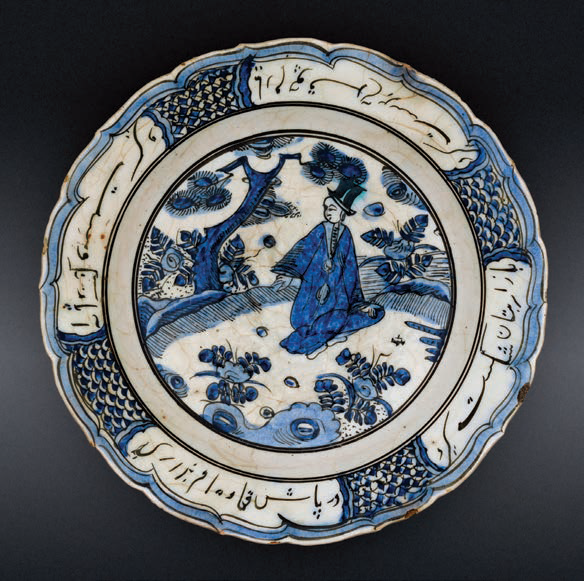
Some Safavid blue and white ceramics depart from the traditional palette by adding red or polychrome slip patterns from Islamic book covers and manuscript illumination to Chinese-style landscapes or motifs (28, 29, 30). The leaf-curl diaper pattern, and a tassel mark on the base of the octagonal tray (30), suggest mid-17th century Kirman production. 53 The tray has an unusual shape, perhaps fashioned to suit foreign tastes. VOC records from the 17th century mention an order from a European customer for octagonal beakers, dishes and small cups. After Jingdezhen production recommenced in 1683, Persian blue and white wares could not contend with the large quantities of Chinese exports. Further factors, including competition from Japanese exports and European blue and white ceramics made for European consumers, likely influenced Persian potters’ experimentation with different techniques. They found success in new directions, including reviving lustreware, a luxury technique that had been nearly dormant for some 300 years.
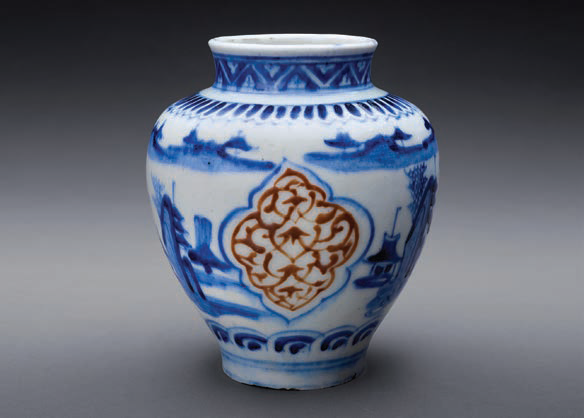
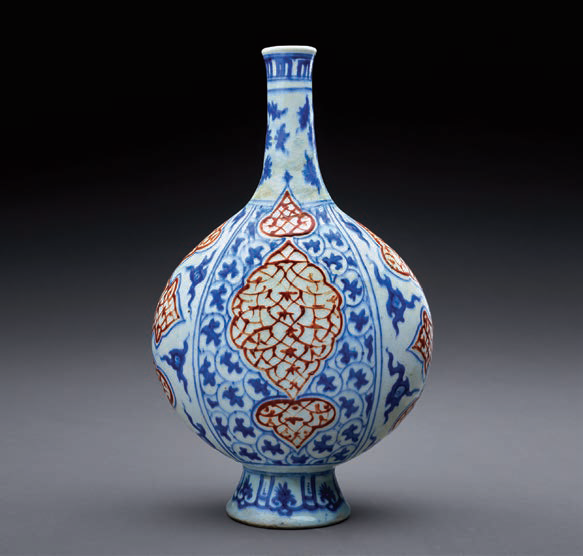

Conclusion
This article has approached blue and white ceramics through the unique lens of an exceptional group of 9th to 17th century Persian ceramics, part of the larger corpus of Persian art from the Hossein Afshar Collection on long-term loan to the MFAH. From early blue and white earthenware to the proliferation of techniques, shapes and glazes made possible by the development of stone-paste, inventive Persian potters continuously expanded their repertoire, often in exchange with China, and made lavish use of the locally sourced and internationally prized blues, cobalt and turquoise, adding brilliant colour to vessels of the Persian table and tiled domes dotting the skies. From the late 15th to the 17th century was an extremely fruitful period of Persian blue and white pottery production, with Chinese export porcelain providing a catalyst for sources of inspiration. It is hoped that these ceramics shed light on a new and more nuanced understanding of the many complex layers of technical proficiency and artistic exchange between Persia and China and the significant contribution of Persian blue and white ceramics to the world history of ceramics. By land and sea, the routes of artistic, technical and economic exchange with China, as well as other points east and west in the interconnected globe at the dawn of the early modern era, were not bilateral but multi-directional, enriched by many layers of intersection and influence.
1 This area of the literature only recently has received more scholarly attention, building upon, among others, the studies of Lisa Golombek, Robert Mason and Gauvin Bailey (see Golombek, Lisa, et al., Tamer Lane’s Tableware: A New Approach to the Chinoiserie Ceramics of Fifteenth- and Sixteenth-Century Iran, Costa Mesa, CA: Mazda Publishers, 1996 and Golombek, Lisa, et al., Persian Pottery in the First Global Age: The Sixteenth and Seventeenth Centuries, Leiden, Netherlands: Brill, 2014) and Yolande Crowe (see Crowe, Yolande, Persia and China: Safavid Blue and White Ceramics in the Victoria and Albert Museum, 1501–1738, [London]: La Boric, 2002). Literature up to 2014 is reviewed in Golombek et al., Persian Pottery, pp. 2-4.
2 A catalogue publication of the complete range of blue and white ceramics, as well as the other Persian ceramics, in the Hossein Afshar Collection, is forthcoming.
3 Krahl, Regina, and Alison Effeny, Shipwrecked: Tang Treasures and Monsoon Winds, Washington, DC: Arthur M. Sackler Gallery, Smithsonian Institution, 2010.
4 It is my privilege to recognise Will Kwiatkowski, independent scholar and epigrapher, for all translation credits in this article, unless otherwise noted. Will Kwiatkowski indicates that the name of the maker here has not been deciphered. Orthographic inconsistencies, as well as restoration, present challenges in the reading of many of the inscriptions on objects of this type. For related items, see bowls in the Detroit Institute of Arts (54.498); the Nasser D. Khalili Collection (POT 296) and the Museum of Islamic Art, Doha (PO.31.1999); Five Continents Museum, Munich (SMV 28-8-2); and the Louvre Museum, Paris (MAO 20).
5 Allan, James, Abu’l-Qsisim’s Treatise on Ceramics, London: British Institute of Persian Studies, 1973, pp. 111–120. For references Lo the development of stone-paste in Iran and Syria, see Rugiadi, Martina, “Stonepaste Technology in Syria and Iran”, in Court and Cosmos: The Great Age of the Seljuqs, Sheila Canby et al., New Haven: Yale University Press, 2016, no. 2, pp. 325–326 as well as discussion on 179ff.
6 Gibson, Melanie, “Ewer”, in Bestowing Beauty Masterpieces from Persian Lands-Selections from the Hossein Afshar Collection, edited by Aimée Froom, New Haven: Yale University Press, 2019, cat. 47, pp. 154–155. Gibson notes that a singular fragmentary piece from the Khalili Collection, London, has the same pear-shaped body and transparent blue glaze as the present ewer. It is moulded with an inscription giving the name of its maker, Ali Buhuni, and the date AH 534/AD 1139–1140. London, Khalili Collection (POT 1460).
7 Pierson, Stacey, Designs as Signs: Decoration and Chinese Ceramics, London: Percival David Foundation of Chinese Art, 2001, p. 19. The Victoria and Albert Museum (C.922 and C.923–1921), London, has two Longquan bowls, excavated in Cairo, with petal-moulded exteriors and paired fish interiors.
8 The Museum of Fine Arts, Houston has an intact glass beaker with fish (70.1 I 0).
9 See Squires, Margaret, “Basin”, in Bestowing Beauty, cat. 59, pp. 184–185.
10 Gibson, Melanie, “Bowl”, in Bestowing Beauty, cat. 90, pp. 258–259.
11 See Golombek et al., Tamerlane’s Tableware, pp. 118–119.
12 Baltimore, Wailers Art Gallery (48.1031), illustrated in Golombek et al., Tamerlane’s Tableware, pl. 50, p. 209. See also The Metropolitan Museum of Art, 40.170.635; Gibson, Melanie, “Bowl”, in Bestowing Beauty, cat. 45–46, pp. 156–157.
13 Masuya, Tomoko, “Ilkhanid Courtly Life”, in The Legacy of Genghis Khan: Courtly Art and Culture in Western Asia, 1256–1353, edited by Linda Komaroff and Stefano Carboni, New York: The Metropolitan Museum of Art, 2002, pp. 75–103.
14 Soucek, Priscilla, “Ceramic Production as Exemplar of Yuan-IIkhanid Relations”, RES: Anthropology and Aesthetics 35 (1999): 126, pp. 131–132.
15 Will Kwiatkowski indicates that this Persian text is very unlikely to be from the Shahnama given the use of Arabic words, such as hukm (command) and azal (pre-eternity).
16 See Squires, Margaret, “Tile”, in Bestowing Beauty, cat. 24, pp. 102–103, who notes that the British Museum tile (1896,0314.32) was likely made from the same mould. The David Collection, Copenhagen, tile is inv. no. 12/1962.
17 Similar tiles are found in the collections of the Ashmolean Museum, University of Oxford (EAX.3195), Los Angeles County Museum of Art, California (1996.115.1-.5), and the Victoria and Albert Mueum of Art, London (1834:2-1876).
18 Will Kwiatkowski indicates that these verses are common on 13th century ceramics. This translation is taken from that provided by Manijeh Bayani for a bowl in the Harvey P. Plotnick Collection. See Pancaroglu, Oya, Perpetual Glory: Medieval Islamic Ceramics from The Harvey B. Plotnick Collection, Chicago: The Art Institute of Chicago, 2007, no. 62, p. 76. for the attribution to Majd al-Din Baghdadi, see Shirvani, J.K., Nuzhat al-Majalis, Tehran: Zavvār, 1375/1996, no. 3698, p. 628.
19 Gibson, Melanie, “Star Tile”, in Bestowing Beauty, cat. 36, pp. 136–137.
20 Copenhagen, David Collection (12/1963), Komaroff, Linda, and Stefano Carboni (eds), The Legacy of Genghis Khan: Courtly Art and Culture in Western Asia, 1256–1353, New York: The Metropolitan Museum of Art, 2002, p. 100, fig. 115.
21 Boston, Museum of Fine Arts (31.729), Weinstein, Laura, Ink, Silk & Gold: Islamic Art from the Museum of Fine Arts, Boston, Boston: MFA Publications, 2015, 77, cat. 46. Komaroff and Carboni, The Legacy of Genghis Khan, p. 101, fig. 116.
22 British Museum (1890,0517.14).
23 This tile is closely related to a mihrab tile panel in The Metropolitan Museum of Art, New York, dated AH 722/AD 1322–1323, Metropolitan Museum (1983.345). Teece, Denise, “Tile from a Mihrab”, in Masterpieces from the Department of Islamic Art in the Metropolitan Museum of Art, edited by Maryam Ekhtiar et al., New York: The Metropolitan Museum of Art, 2011, cat. 80, pp. 123–124.
24 McCausland, Shane, The Mongol Century: Visual Cultures of Yuan China, 1271–1368, London: Reaktion Books, 2015, pp. 218–219, for mention of 2009 excavations at a site in Jingdezhen by the Chinese scholar, May Huang.
25 The MFAH would especially like to recognise Dr Emily Sano, Co-Interim Director, Coates-Cowden-Brown Senior Advisor for Asian Art, and Shawn Yu, Assistant Curator of Asian Art, of the SAMA. For the SAMA collection, see Johnston, John, Chinese Ceramics: The Lenora and Walter F. Brown Collections of Chinese Ceramics, San Antonio: San Antonio Museum of Art, 2014.
26 Thrcc duck pair dishes from the Ardabil Shrine are published in Pope, John Alexander, Chinese Porcelain from the Ardebil Shrine, Washington, DC: Smithsonian Institution, Freer Gallery of Art, 1956, Vol. 2, no. 1, objects 29.40 I; 29.123; and 29.129. A duck pair bowl in the Topkapi Palace is published in Pope, John Alexander, Fourteenth-Century Blue and White: A Group of Chinese Porcelains in the Topkaki Sarayi Muzesi, Istanbul, Washington, DC: Smithsonian Institution, Freer Gallery of Art, 1952, Vol. 2, no. 1, plate 20, TKS 1379. See Johnston, Chinese Ceramics, cat. 49, 80 and 150, no. 66.
28 A small group of early Ming dishes with Shah Jahan inscriptions, including some with dates, has been identified and can be found in Krahl, Regina, “Porcelain Diplomacy”, Important Chinese Works of Art, Sotheby’s, New York, March 2015. Hups://www.sothebys.com/content/sothebys/en/news-video/ auction-essays/chinese-works-of-art-n09317/2015/02/porcelain-diplomacy.html.
29 This dish was formerly in the Guennol Collection on loan to the Brooklyn Museum (1991–2006), now in the Museum of Islamic Art, Doha. See Soudavar, Abolala, “A Chinese Dish from the Lost Endowment of Princess Sultanum (925–69/1519–62)”, in Iran and Iranian Studies in Honor of lraj Afshar, edited by Kambiz Eslami, Princeton: Zagros, 1998, pp. 125–134.
30 See Johnston, Chinese Ceramics, cat. 42, 84 and 150, notes 69–70; and J.A. Pope, Chinese Porcelain, cat. nos 29.101–29.111. For a British Museum dish, see Harrison-Hall, Jessica, Catalogue of Late Yuan and Ming Ceramics in the British Museum, London: British Museum Press, 2001, p. 116. For a Meiyintang Collection dish, see Krahl, Regina, Chinese Porcelain from the Meiyintang Collection, Vol. 2, London: Azimuth Editions, 1994, pp. 52–53. See also Minneapolis Institute of Art, 2004.132.5, among others.
31 Harrison-Hall, Jessica, “Large Serving Dish” in Shah ‘Abbas: The Remaking of Iran, edited by Sheila Canby, London: The British Museum Press, 2009, cat. 55, p. 137; and Wood, Nigel, Chinese Glazes: Their Origins, Chemistry and Recreation, London: A. & C. Black, 1999, pp. 63–64, who indicates that manganese-cobalt pigments, which were lower in iron, were used in the 15th century.
32 Kerr, Rose, “The Fashion for Foreign: Outside Influences on Chinese Ceramics”, in Johnston, Chinese Ceramics, p. 31. For the metalwork canteen, see the canteen in the Freer Gallery of Art, Smithsonian Institution, Washington, DC, F194I.I0.
33 Gibson, Melanie, “Dish”, in Bestowing Beauty, cal. 91, pp. 260–261. See McCausland, The Mongol Century, pp. 218–219, figs 142–143 for May Huang 2009 excavations at Jingdezhen for Persian participation in blue and white porcelain production.
34 For the “Precise” group, see Golombek et al., Persian Pottery, pp. 61–66; Golombek et al., Tamerlane’s Tableware, p. 120. Works have been attributed to Tabriz, Nishapur and Iznik. For a comparable piece, see Victoria and Albert Museum C.30-1960 illustrated in Crowe, Persia and China, p. 51, fig. 3, and Golombek et al., Tamerlane’s Tableware, p. 222, pl. 66.
35 See Lentz, Thomas W. and Glenn D. Lowry, Timur and the Princely Vision: Persian Art and Culture in the Fifteenth Century, Washington, DC: The Arthur M. Sackler Gallery, Smithsonian Institution; Los Angeles: The Los Angeles County Museum of Art, 1989, p. 112, cal. no. 32; and Gibson, Melanie, “Dish”, in Bestowing Beauty, cat. 71, pp. 214–215.
36 Clavijo, Ruy Gonzales, Embassy to Tamerlane 1403–1406, edited by E. Denison Ross, translated by Guy LeStrange, London: Routledge & Sons, 1928; London: Routledge Curzon, 2005, p. 110; quoted in Gibson, Melanie, “Dish”, in Bestowing Beauty, p. 214.
37 Golombek et al., Persian Pottery, p. 24, no. 79. Olearius, Adam, The Voyages & Travels of the Ambassadors Sent by Frederick Duke of Holstein, to the Great Duke of Muscovy, and the King of Persia, Begun in the Year 1633 and finished in 1639. Containing a Complete History of Muscovy, Tartary, Persia, and Other Adjacent Countries, trans. John Davies, London, 1662, p. 179.
38 See Squires, Margaret, “Wine, Coffee and Tobacco: The Pleasures of Blue and White in Safavid Iran”, in this issue; and Crowe, Persia and China, pp. 21–22.
39 Golombek el al., Persian Pottery, pp. 46–49; and Crowe, Persia and China, pp. 98–101.
40 Gibson, Melanie, “Kendi-shaped Qalyan (Hookah) base”, in Bestowing Beauty, cat. 53–54, pp. 172–175.
41 Golombek el al., Persian Pottery, pp. 245–248, 254.
42 Ashmolean, EA1978.1777; V&A 1468–1876 (Crowe, Persia and China, fig. 67) and 1155–2876 (Crowe, Persia and China, fig. 68); Topkapi Palace Museum, TKS 993. See Golombek et al., Persian Pottery, pp. 133–134; and Crowe, Persia and China, pp. 78–81.
43 Golombek el al., Persian Pottery, p. 131.
44 The Persian term darvish was used to refer both to wandering ascetics and to the Sufis, who were part of mystical Islamic orders; Algar, Hamid, “Darviss. ii. In the Islamic Period”, Encyclopedia lranica. See Simpson, Marianna Shreve, “Dervish”, in Bestowing Beauty, cat. 7, pp. 58–60.
45 Will Kwiatkowski suggests that “65” might alternatively represem an inventory record.
46 Golombek el al., Persian Pottery, pp. 98–101. For the list, see p. 99, no. 73. The present dish was identified by Golombek with its 1978 auction catalogue information, yet a question remained about the date. See p. 47 where it is identified as “ZZZ.30”.
47 Golombek et al., Persian Pottery, pp. 248–252.
48 Will Kwiatkowski would like to thank Manijch Bayani and Wheeler Thackston for their assistance in translating this poem. For discussion, see Gibson, Melanie, “Dish”, in Bestowing Beauty, cat. 55, pp. 172–175.
49 Will Kwiatkowski, October 2019. See Muhammad Rizaquli Khan, Taz:kira-yi Riyaz al-‘Arifin, edited by Sayyid Riza Vahidi and Suhrab Zari’, Tehran 1375/1996–1997, p. 71.
50 Will Kwiatkowski, October 2019. For a published translation, see The Collected Lyrics of Hafiz of Shiraz, trans. Peter Avery, Cambridge: Archetype, 2007, p. 196, no. 144.
51 Golombek dates the Hossein Afshar dish to circa 1640. Personal communication, June 9th, 2020. See also ROM 908.22.1. Golombek et al., Persian Pottery, cat. 16, pp. 318–319.
52 Golombek et al., Persian Pottery, pp. 229–230.
53 Golombek et al., Persian Pottery, pp. 105–107. The tassel mark on the octagonal tray is identified here as part of the “tail-flourish” group, a small group of three known vessels from Phase III (1650–1680), including one dated 1673–1674 in the Royal Ontario Museum, Toronto; for the tassel mark, see pp.107, 251, 256, and for ROM 2000.48.1, see cal. 22, pp. 334–337.

 Subscribe
Subscribe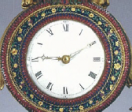 Calendar
Calendar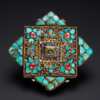 Links
Links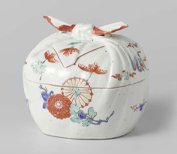 Gift
Gift


